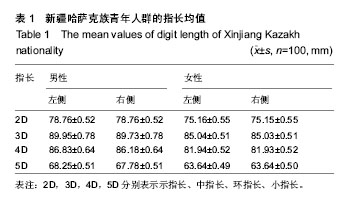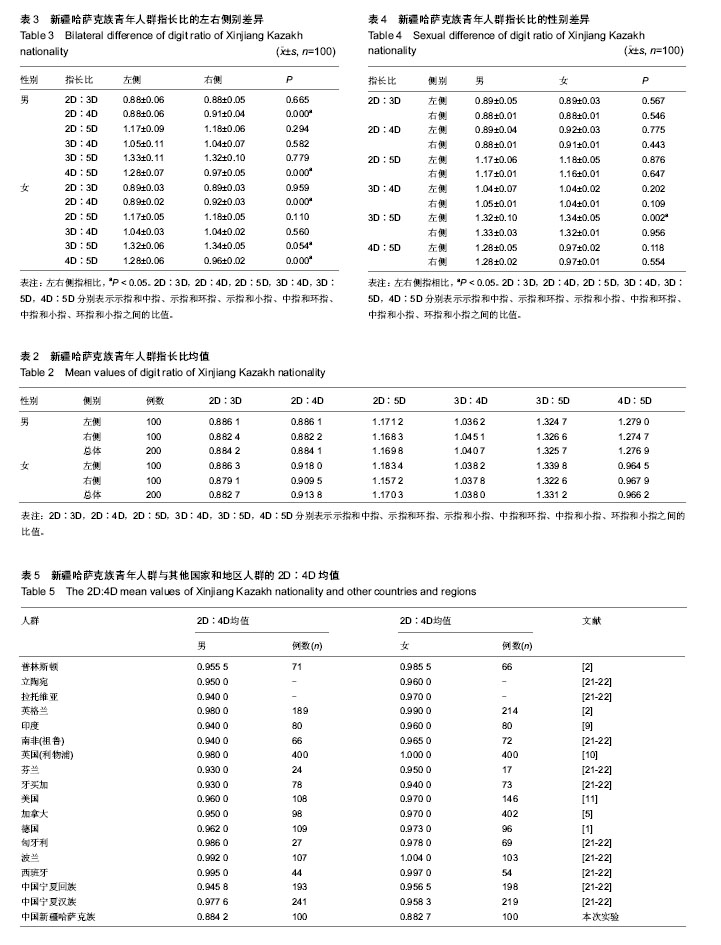| [1] Manning JT, Scutt D, Wilson J, et al. The ratio of 2nd to 4th digit length: a predictor ofsperm numbers and concentrations of testosterone, luteinizing hormone and oestrogen. Hum Reprod. 1998;13:3000-3004.
[2] Manning JT, Bundred P. The ratio of 2nd to 4th digit length:a new predictor of disease predisposition. Med Hypotheses. 2000;54(5):855-857.
[3] Williams TJ, Pepitone ME, Christensen SE, et al. Finger-length ratio and sexual orientation. Nature. 2000; 404:455-456.
[4] Brown WM, Hines M, Fane BA, et al. Masculinized finger length patterns in human malesand females with congenital adrenal hyperplasia. Horm Behav. 2002;42(4):380-386.
[5] Mclntyre MH, Cohn BA, Ellison PT. Sex dimorphism in digital for mulae of children. Am J Phys Anthropol. 2006;129(1): 143-150.
[6] McIntyre MH. The use of digit ratios as markers for perinatal and rogenaction. Reprod Biol Endocrinol. 2006;26:4-10.
[7] Manning JT, Barley L, Walton J, et al. The 2nd: 4th digit ratio, sexual dimorphism, population differences,and reproductive success: evidence for sexually antagonistic genes. Evol Hum Behav. 2000;21:163-183.
[8] Manning JT, Henzi P, Venkatramana S. Second to fourth digitratio ethnic differences and family size in English, Indian and South African populations. Ann Hum Biol. 2003;30(5): 579-588.
[9] Manning JT, Henzi P, Bundred PE. The ratio of 2nd to 4th digit length: a proxy fortestosterone, and susceptibility to HIV and AIDS. Med Hypotheses. 2001;57(6):761-763.
[10] Manning JT, Callow MP, Bundred E. Finger and toe ratios in humans and mice: implications fortheaetiology ofdiseases influenced byHOX genes. Med Hypotheses. 2003;60(3): 340-343.
[11] Ronalds GW, Phillips Dl, Godfrey KM, et al. The ratio of second to fourth digit length: amarker of impaired fetal growth. Early Hum Dev. 2002;70:21-26.
[12] Phillips GB, Pinkemell BH, Jing TY. The association of hypotesteronemia with conronary artery diseases in men. Aterioscler Thromb. 1994;14(5):701-706.
[13] 陆宏,霍正浩,张科静,等.指长比与冠心病的相关性研究[J].解剖学报,2008,39(5):765-768.
[14] 陆宏,霍正浩,陈静等.指长比与乳腺癌的相关性研究[J].人类学学报,2008,27(4):359-363.
[15] 罗桐秀,黄春霞.人类HOX基因改变导致肢体畸形的研究进展[J].国外医学遗传学分册,2005,28(2):105-108.
[16] Goodman FR, Scambler PJ. Human HOX gene mutations. Clin Genet. 2001;59(1):1-11.
[17] Peichel CL, Prabhakaran B, Vogt TF. The mouse Ulnaless mutation deregulates posterior HoxD gene expression and alters appendicular patterning. Development. 1997;124(18): 3481-3492.
[18] Herault Y, Fradeau N, Zakany JU. A regulatory mutation in ducing both loss-of-function of posterior Hoxd genes. Development. 1997;124(18):3493-3500.
[19] 梁艳明,席焕久,李明,等.人类指长比的研究进展[J].解剖科学进展,2008,14(4):449-452.
[20] Manning JT, Bundred PE, Flanagan BF. The ratio of 2nd to 4nd digit length:a proxy for transaction activityof the androgen receptorgene. Medical Hypotheses. 2002;59(3):334-336.
[21] 席焕久,胡荣,温有锋,等.辽宁汉族指长及指长比的特点[J].解剖学报,2010,41(3):471-479.
[22] 王景靓,徐飞,李岩,等.大连汉族群体的指长比特点[J].解剖学报, 2010,41(5):751-755.
[23] 努尔买买提•巴哈夏尔,董建江,爱华,等.哈萨克族成人掌骨的X线测量与身高的回归分析[J].解剖学杂志,2010,33(6):802-805.
[24] 努尔买买提•巴哈夏尔,董建江,爱华,等.哈萨克族成人掌骨的X线测量及其与身高的性别判别分析[J].解剖学报,2010,41(1): 151-154.
[25] 李建福,骆文斌,余跃生,等.布依族群体指长比的研究[J].现代预防医学,2011,38(1):97-99.
[26] 努尔买买提•巴哈夏尔,爱华,吴海忠,等.哈萨克族成人指骨长度与身高的性别判别[J].解剖学报,2013,44(5):736-740.
[27] 努尔买买提•巴哈夏尔,凯赛尔江•多来提,爱华,等.新疆哈萨克族成人指骨长度与身高的逐步回归分析[J].东南大学学报(医学版), 2013,32(5):591-594.
[28] 孙进,李岩,徐飞.鞍山市304名汉族成人手部44项形态学指标特点[J].中国组织工程研究与临床康复,2007,11(6):1099-1105.
[29] 马坚妹,徐飞,赵薇,等.辽宁汉族青年手的体质人类学研究一手指部分[J].大连医科大学学报,1999,21(4):300-302.
[30] 王衡,关华忠,龚鹏鸣.维吾尔族手的测量与指型观察[J].人类学学报,1985,4(1):80-93.
[31] 陆宏,霍正浩,师志云,等.宁夏回族和汉族群体指长比的研究[J].解剖学报,2008,39(2):267-271.
[32] Vehmas T, Soiovieva S, Leino-arjas P. Radiographic 2D:4D index in females: no relation to anthropometric, behavioural, nutritional, health-related, occupational or fertility variables. J Negat Resuits Biomed. 2006;5:12-19.
[33] Lee Y, Lee JY, Kim MH. PI3K/Akt pathway regulates retinoic acid-induced Hox gene expression in F9 cells. Dev Growth Differ. 2014;56(7):518-25.
[34] Pradeepa MM, Grimes GR, Taylor GC, et al. Psip1/Ledgf p75 restrains Hox gene expression by recruiting both trithorax and polycomb group proteins. Nucleic Acids Res. 2014;42(14): 9021-9032.
[35] Bhatlekar S, Fields JZ, Boman BM. HOX genes and their role in the development of human cancers. J Mol Med (Berl). 2014; 92(8):811-823.
[36] Martin KJ, Holland PW. Enigmatic orthology relationships between hox clusters of the african butterfly fish and other teleosts following ancient whole-genome duplication. Mol Biol Evol. 2014;31(10):2592-2611.
[37] Bacino CA, Hecht JT. Etiopathogenesis of equinovarus foot malformations. Eur J Med Genet. 2014;57(8):473-479.
[38] Woltering JM, Noordermeer D, Leleu M, et al. Conservation and divergence of regulatory strategies at Hox Loci and the origin of tetrapod digits. PLoS Biol. 2014;12(1):e1001773.
[39] Berlivet S, Paquette D, Dumouchel A, et al. Clustering of tissue-specific sub-TADs accompanies the regulation of HoxA genes in developing limbs. PLoS Genet. 2013;9(12): e1004018.
[40] Tsumagari K, Baribault C, Terragni J, et al. DNA methylation and differentiation: HOX genes in muscle cells. Epigenetics Chromatin. 2013;6(1):25.
[41] Sheth R, Bastida MF, Kmita M, et al. “Self-regulation,” a new facet of Hox genes' function. Dev Dyn. 2014;243(1):182-191.
[42] Sheth R, Grégoire D, Dumouchel A, et al. Decoupling the function of Hox and Shh in developing limb reveals multiple inputs of Hox genes on limb growth. Development. 2013; 140(10):2130-2138. |

